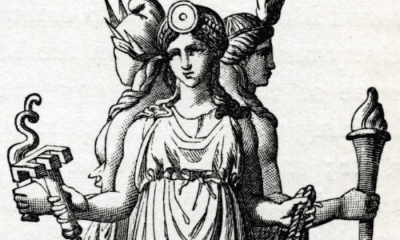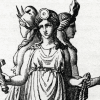Greek
The Hades and Persephone Story
The story of Hades and Persephone is one of the most famous in Greek mythology. Read on to find out what the marriage story meant in Greek culture!
In both the ancient world and the modern one, the marriage story of Hades and Persephone has been one of the most often-discussed in Greek mythology.
Ancient people saw the marriage of the god of the dead and the goddess of spring as the heart of the cycles of the seasons and of life and death. Modern readers examine the kidnapping of the young goddess into a forced marriage.
While the Greeks had a much different idea of marriage than modern readers, many saw the union of Hades and Persephone as one of the most important among the gods. The Hades and Persephone story illustrated not only marriage, but also the complex relationship between life and death in the ancient world.
The Story of Hades and Persephone
According to Greek mythology, Persephone was the beautiful young daughter of Demeter, the goddess of grain. One of the most popular versions of the story claimed that Zeus was her father, although others did not name him.
Demeter was extremely devoted to her daughter and the two were constant companions. Persephone was known for her beauty and grace.
Zeus, however, decided that Persephone’s time as a young maiden who spent all her time with her mother would come to an end. As the king of the gods, and possibly her father, he had the right to arrange her marriage to the man he chose.
Zeus chose for her to marry Hades. His brother was the lord of his own realm and a powerful god, so he felt that it was a good match that would benefit both.
He knew, however, that Demeter would object. She would not want to be separated from her beloved daughter, who would be taken to the Underworld as the bride of Hades.
The two gods decided, therefore, not to tell Demeter what they had planned for her daughter.
They waited for one of the rare moments when Persephone and her mother were not together. One day when the younger goddess was collecting flowers with some nymphs, Hades burst out of the Underworld in his chariot and grabbed her, pulling her to the land of the dead and closing the entrance before anyone could react.
Some versions of the story claimed that the nymphs who were with her that day fled in terror. Others said that they were so frightened that they could not speak.
Either way, Demeter could receive no information from them when she realized that her daughter was missing. With no other witnesses, she had no idea where Persephone had gone.
According to some sources, Persephone had only had time to let out a single scream before she was taken into the Underworld. Hearing this, Demeter was certain that something terrible had happened to her.
Demeter began searching the world over for her missing daughter. She wandered from place to place looking for information, neglecting her duties to make grain grow as she did.
After several days of searching, Demeter was bedraggled and half-starved but still did not know where Persephone had gone or who had taken her. Eventually, according to many sources, she came across Hecate.
Hecate had no information either, but told Demeter to ask Helios what had happened. From his place high in the sky, the god of the sun bore witness to everything that happened on earth.
Helios had, indeed, seen the entire abduction. When Demeter learned that Hades had taken her daughter, she knew that Zeus was involved as well.
She returned to Olympus and demanded answers from her brother. Not only had he allowed Hades to take Persephone, but he had also lied to her and let her continue her fruitless search when he knew where the young goddess was.
The goddess of grain demanded that her daughter be returned. If she was not, Demeter swore that she would stop crops from growing entirely.
If she did that, Zeus knew, the human population would soon starve. This would also mean that the gods would not receive the sacrifices they relied on from the people of earth.
He commanded Hades to bring Persephone back to the surface. Hades put Persephone in his chariot and began the journey out of the Underworld.
As they traveled, however, he offered her a pomegranate. Some sources claimed that she ate some of it willingly, being hungry after days in the Underworld, while others said that the god of the dead tricked her into eating a few seeds.
When they came to the surface, Demeter was overjoyed at her daughter’s return. This happiness would be short-lived, though.
Because she had eaten food from the Underworld, Persephone was forever bound to that place. It would be impossible for her to return to the world of the living for good.
A compromise was reached to pacify Demeter and maintain the marriage between Hades and Persephone. The young goddess would live with her mother most of the time but return to her husband and his realm for one-third of the year.
When Persephone was with her mother, Demeter was happy. Grains and other plants grew and flourished.
When she returned to the Underworld, however, Demeter fell into mourning. For three months of the year, the winter, nothing would grow and the land would become barren.
My Modern Interpretation
The story of Hades and Persephone is one of the most well-known, and most widely-discussed, tales of Greek mythology.
At its surface, it is an explanation for the cycle of the seasons. The yearly disappearance of the grain goddess’s daughter justified why crops did not grow during the winter months.
Historians, and Greek sources themselves, offer much deeper interpretations of this tale, however.
The marriage of Hades and Persephone symbolized the relationship between life and death. In the ancient view of the world, the two were inseparable.
New growth, which Persephone became the goddess of, came from the ground. Seeds, which appeared to be dead, were placed into the earth just as the bodies of the deceased were. From them came new life.
Dead matter nurtured this life, providing necessary nutrients in the soil to make plants larger and stronger. To the ancients, life and death existed in a cycle in which each relied on the other.
The myth of Hades and Persephone symbolized this cycle. She returned to the living each spring just as the plants did.
This idea was especially embraced by Greece’s mystery cults, who left numerous writings and works of art devoted to Persephone. Their focus was on learning the secrets of death and its central place in the world, so Persephone was an important link between this world and the afterlife for them.
In fact, most Greek myths and legends show Persephone in her role as the queen of the Underworld rather than the goddess of new life. When heroes such as Heracles or Orpheus went to Hades’ realm, they saw Persephone regardless of the season.
Often, Persephone was a figure of mercy and kindness in these stories. The queen of the dead represented a more loving, maternal aspect of the Underworld than her more stern husband.
Many historians believe that the story of Hades and Persephone also represents a mythologized view of how marriage worked in much of the ancient world.
Like Persephone, the majority of young women in the ancient world were given into arranged marriages by their fathers. Both the bride and her mother would typically have little to no say in these unions and, as in the myth, sometimes did not even know a marriage had been arranged in advance.
Beyond that, however, there is evidence that the story of Hades and Persephone reflects a ritual that had been carried into Greek culture from even more ancient traditions.
A brutal but common aspect of ancient warfare was the forcible kidnapping of young women. They would be married to their kidnappers and often never see their own families again.
Stories of such marriages by kidnapping can be found from around the world. The Old Testament of the Bible has many such stories, Ghengis Khan’s mother was taken in this way, and many Native American cultures practiced the custom.
In ancient Greece, a more settled culture with a stronger legal system meant that raids against one’s neighbor were less common than negotiations and trade. The custom of stealing a bride, however, remained.
Ancient sources often recount night-time raids as a tradition in ancient Greek marriages in which a groom would sneak into his new bride’s family home and take her back to his own. Like the bride being given away in a modern wedding this was a tradition rather than a literal kidnapping.
Some historians believe that the story of Hades and Persephone can be interpreted as a version of this real-world tradition, which was likely a continuation of a more brutal and ancient custom. While Persephone and her mother had no say in the marriage, her abduction was lawful because it was part of a marriage that had been arranged by her father.
In Summary
According to Greek legends, Hades abducted Persephone to marry her.
The marriage had been arranged by Zeus, the king of the gods and in some versions Persephone’s father. Because her mother, Demeter, would object, however, Zeus hid his plans from her.
Instead, Hades kidnapped the young goddess and took her to the Underworld. Demeter searched in vain before learning of her brothers’ plans.
Demeter threatened to use her power as the goddess of grains and crops to cause devastating famines if her daughter was not returned. Because Persephone had eaten food from the Underworld, however, she was eternally tied to that place.
As a compromise, Persephone was permitted to spend much of the year with her mother. When they were together, Demeter rejoiced and crops grew well.
For three months of the year, however, Persephone returned to her husband’s realm. Demeter mourned and nothing would grow.
The most common and basic interpretation of this story is that it explained the cycle of the seasons. When Demeter went into mourning over her daughter’s absence, it was winter and crops would not grow, but when Persephone returned life rebounded in the spring.
The Greeks also believed the story represented the cycle of life and death. New growth came from beneath the ground from seemingly dead seeds, linking the land of the dead and the return of life in the spring.
While the story of Persephone’s kidnapping is infamous to modern readers, some historians also believe it represented Greek marriage customs. While abductions were a common way to bring new women into a community in many ancient cultures, the Greeks ritualized this practice as part of the marriage ceremony.
The story of Hades and Persephone thus shows many aspects of ancient Greek culture and belief. From the local traditions of arranged marriages to the cycles of life and death, the king and queen of the Underworld were central figures in the Greek worldview.



